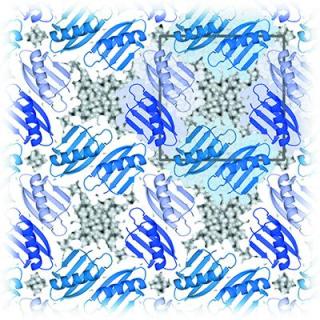Jun 27 2015
The mother liquor from which a biomolecular crystal is grown will contain water, buffer molecules, native ligands and cofactors, crystallization precipitants and additives, various metal ions, and often small-molecule ligands or inhibitors. On average, about half the volume of a biomolecular crystal consists of this mother liquor, whose components form the disordered bulk solvent.
 Given favorable kinetics, macromolecules can self-assemble from a metastable, supersaturated solution into crystals, a periodic network of macromolecules connected by weak but specific intermolecular interactions. Credit: Weichenberger et al.
Given favorable kinetics, macromolecules can self-assemble from a metastable, supersaturated solution into crystals, a periodic network of macromolecules connected by weak but specific intermolecular interactions. Credit: Weichenberger et al.
The solvent is therefore integral and also often an intrinsic part of almost any macromolecular crystal structure. Its disordered bulk components as well as its ordered constituents of varying nature need to be accounted for in modelling and refinement. The improvement of bulk-solvent description from a fundamental perspective is largely driven by methods development. In bulk-solvent refinement, users have limited choice beyond solvent-model selection and therefore not much opportunity for the introduction of bias or specific model errors, with the caveat that suboptimal masking sometimes can introduce density artefacts. In contrast, modelling of distinct solvent electron density almost always requires thoughtful interpretation, and using appropriate tools for (automated) building and validation can greatly improve the quality of structure models.
In a paper by [Weichenberger et al. (2015). Acta Cryst. D71, 1023-1038; doi:10.1107/S1399004715006045] a group of authors examine how to estimate the overall solvent content of a macromolecular crystal, how to account for and model disordered bulk solvent and how to properly identify and model distinct electron (or nuclear, in the case of neutron diffraction) density of ordered solvent molecules. The authors also emphasize that modelling of the biologically important interface region between the protein molecule and solvent is still incomplete, and advanced solvent models of these dynamic regions need to be developed.